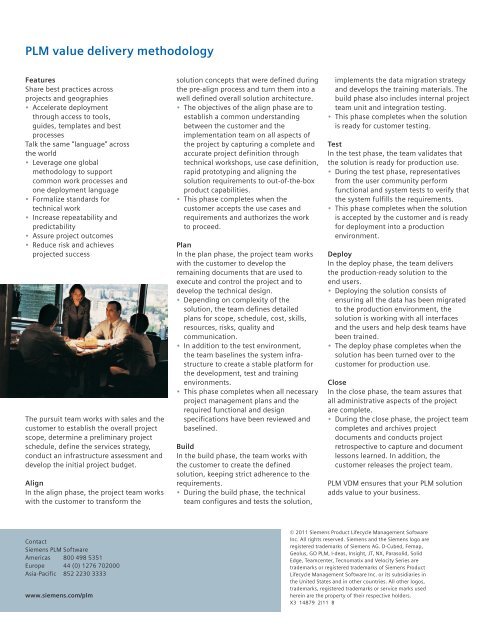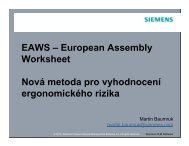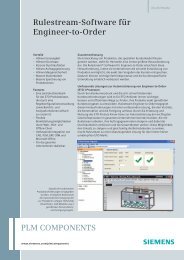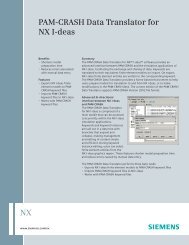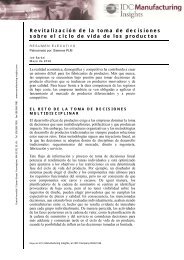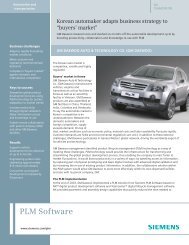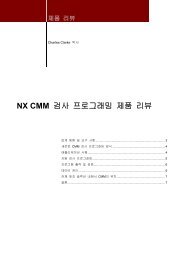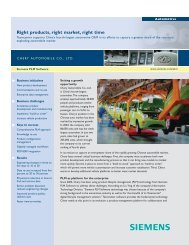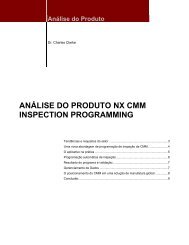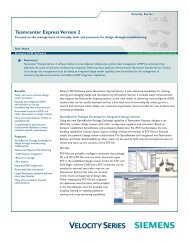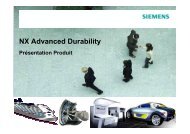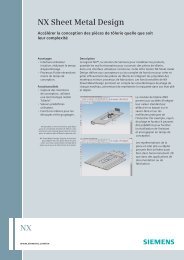PLM value delivery methodology - Siemens PLM Software
PLM value delivery methodology - Siemens PLM Software
PLM value delivery methodology - Siemens PLM Software
Create successful ePaper yourself
Turn your PDF publications into a flip-book with our unique Google optimized e-Paper software.
<strong>PLM</strong> <strong>value</strong> <strong>delivery</strong> <strong>methodology</strong><br />
Features<br />
Share best practices across<br />
projects and geographies<br />
• Accelerate deployment<br />
through access to tools,<br />
guides, templates and best<br />
processes<br />
Talk the same “language” across<br />
the world<br />
• Leverage one global<br />
<strong>methodology</strong> to support<br />
common work processes and<br />
one deployment language<br />
• Formalize standards for<br />
technical work<br />
• Increase repeatability and<br />
predictability<br />
• Assure project outcomes<br />
• Reduce risk and achieves<br />
projected success<br />
The pursuit team works with sales and the<br />
customer to establish the overall project<br />
scope, determine a preliminary project<br />
schedule, define the services strategy,<br />
conduct an infrastructure assessment and<br />
develop the initial project budget.<br />
Align<br />
In the align phase, the project team works<br />
with the customer to transform the<br />
solution concepts that were defined during<br />
the pre-align process and turn them into a<br />
well defined overall solution architecture.<br />
• The objectives of the align phase are to<br />
establish a common understanding<br />
between the customer and the<br />
implementation team on all aspects of<br />
the project by capturing a complete and<br />
accurate project definition through<br />
technical workshops, use case definition,<br />
rapid prototyping and aligning the<br />
solution requirements to out-of-the-box<br />
product capabilities.<br />
• This phase completes when the<br />
customer accepts the use cases and<br />
requirements and authorizes the work<br />
to proceed.<br />
Plan<br />
In the plan phase, the project team works<br />
with the customer to develop the<br />
remaining documents that are used to<br />
execute and control the project and to<br />
develop the technical design.<br />
• Depending on complexity of the<br />
solution, the team defines detailed<br />
plans for scope, schedule, cost, skills,<br />
resources, risks, quality and<br />
communication.<br />
• In addition to the test environment,<br />
the team baselines the system infrastructure<br />
to create a stable platform for<br />
the development, test and training<br />
environments.<br />
• This phase completes when all necessary<br />
project management plans and the<br />
required functional and design<br />
specifications have been reviewed and<br />
baselined.<br />
Build<br />
In the build phase, the team works with<br />
the customer to create the defined<br />
solution, keeping strict adherence to the<br />
requirements.<br />
• During the build phase, the technical<br />
team configures and tests the solution,<br />
implements the data migration strategy<br />
and develops the training materials. The<br />
build phase also includes internal project<br />
team unit and integration testing.<br />
• This phase completes when the solution<br />
is ready for customer testing.<br />
Test<br />
In the test phase, the team validates that<br />
the solution is ready for production use.<br />
• During the test phase, representatives<br />
from the user community perform<br />
functional and system tests to verify that<br />
the system fulfills the requirements.<br />
• This phase completes when the solution<br />
is accepted by the customer and is ready<br />
for deployment into a production<br />
environment.<br />
Deploy<br />
In the deploy phase, the team delivers<br />
the production-ready solution to the<br />
end users.<br />
• Deploying the solution consists of<br />
ensuring all the data has been migrated<br />
to the production environment, the<br />
solution is working with all interfaces<br />
and the users and help desk teams have<br />
been trained.<br />
• The deploy phase completes when the<br />
solution has been turned over to the<br />
customer for production use.<br />
Close<br />
In the close phase, the team assures that<br />
all administrative aspects of the project<br />
are complete.<br />
• During the close phase, the project team<br />
completes and archives project<br />
documents and conducts project<br />
retrospective to capture and document<br />
lessons learned. In addition, the<br />
customer releases the project team.<br />
<strong>PLM</strong> VDM ensures that your <strong>PLM</strong> solution<br />
adds <strong>value</strong> to your business.<br />
Contact<br />
<strong>Siemens</strong> <strong>PLM</strong> <strong>Software</strong><br />
Americas 800 498 5351<br />
Europe 44 (0) 1276 702000<br />
Asia-Pacific 852 2230 3333<br />
www.siemens.com/plm<br />
© 2011 <strong>Siemens</strong> Product Lifecycle Management <strong>Software</strong><br />
Inc. All rights reserved. <strong>Siemens</strong> and the <strong>Siemens</strong> logo are<br />
registered trademarks of <strong>Siemens</strong> AG. D-Cubed, Femap,<br />
Geolus, GO <strong>PLM</strong>, I-deas, Insight, JT, NX, Parasolid, Solid<br />
Edge, Teamcenter, Tecnomatix and Velocity Series are<br />
trademarks or registered trademarks of <strong>Siemens</strong> Product<br />
Lifecycle Management <strong>Software</strong> Inc. or its subsidiaries in<br />
the United States and in other countries. All other logos,<br />
trademarks, registered trademarks or service marks used<br />
herein are the property of their respective holders.<br />
X3 14879 2/11 B


